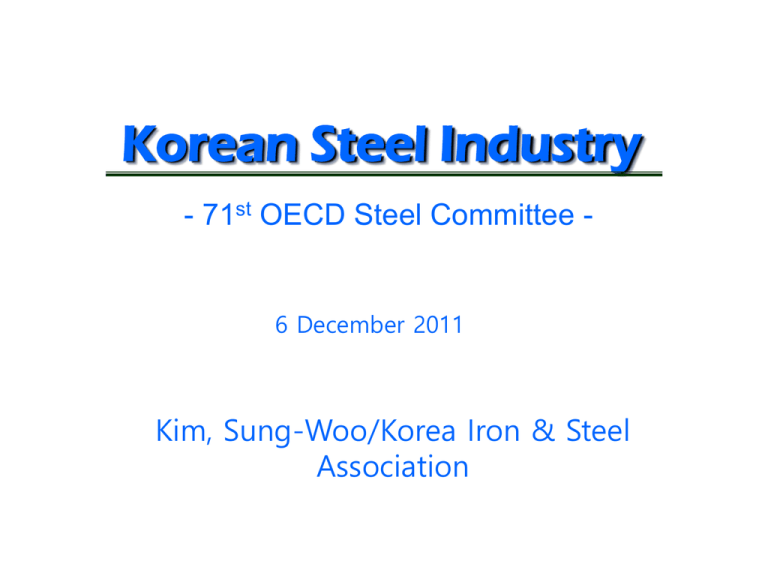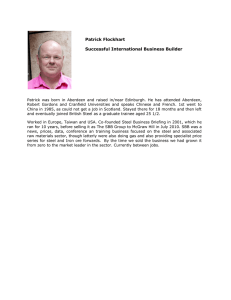Korean Steel Industry - 71 OECD Steel Committee -
advertisement

Korean Steel Industry - 71st OECD Steel Committee - 6 December 2011 Kim, Sung-Woo/Korea Iron & Steel Association Ⅰ. General Economy & Steel Consuming Industry Conten t Ⅱ. Iron & Steel Industry 1. Crude Steel Production 2. Steel Products Supply and Demand 3. Raw Materials Ⅲ. Conclusion I. General Economy & Steel Consuming Industry Economy : GDP growth remains strong but likely slows next year The Korean economy continues growth, estimating 3.8% range in 2011 However, in 2012 a slowdown is expected to around 3.5% amid uncertainty of the global economy Steel consuming industry : Keeps a solid activity in 2011 except construction sector, but weakness is forecast in 2012 Construction : Expected to bottom out in 2012 but very slightly Automobile : Continues strong so far, but likely to slow in 2012 Shipbuilding : Estimated growth in 2011, but turndown is expected Machinery/Domestic Appliance : Continue a satisfactory performance < Steel Consuming Industry> < General Economy in Korea > '11 (Estimate) 13.6 '12 (Forecast) 7.2 8.7 6.0 5.4 0.7 Const. -5.3 4.0 2.2 Auto. Shipbuild -5.0 ↓ Machin. Electro. II. Iron & Steel Industry 1. Crude Steel Production Korea’s crude steel production is estimated 67.4 million tons in 2011, up 14.4% y-o-y, and in 2012 it is expected 69.2 million tons up 2.7% thanks to BOF modernization and EAF well-operation BOF : 41.7(2011) → 42.0 million tons(2012, 0.7%↑) EAF : 25.7(2011) → 27.2 million tons(2012, 5.8%↑) * EAF share(%) : 46.5(’07) → 43.0(’09) → 42.1(’10) → 38.1(’11) → 39.3(’12) 21.3% (Thousand tons, %) 14.4% 67.4 2009 69.2 Mil. 58.9 2.7% 48.6 2011 (E) 2012 (F) 58, 912 67, 400 69, 200 -9. 4 21. 3 14. 4 2. 7 27, 667 34, 111 41, 700 42, 000 Y OY -8. 5 23. 3 22. 2 0. 7 Share EA F 57. 0 57. 9 61. 9 60. 7 20, 905 24, 801 25, 700 27, 200 -10. 7 18. 6 3. 6 5. 8 43. 0 42. 1 38. 1 39. 3 Share 2010 2011(E) 2012(F) (전년비) (Y OY ) B O F Y OY -9.4% 2009 Crude Steel 48, 572 2010 2. Steel Products Demand and Supply Korea’s total steel demand continues growth but it is expected to slow in 2012 because steel consuming industry and export are forecast to weaken in accordance with uncertain global economy Domestic Demand : Estimated 56 million tons in 2011 and expected to increase 1.4%(56.8 million tons) in 2012 Export Demand: Major markets consist of China, Japan and South East Asia. In 2012 the export circumstances are very likely to be weaker < Export > < Demand > 58.6 55.2 45.4 52.4 56.8 56.0 20.8 19.1 10.7 '07 '08 6.9 '09 '10 -22.5 21.1 14.5 15.4 6.2 20.5 29.7 28.5 24.9 '11(E) 5.2 1.4 '12(F) 8.6 '07 4.1 -1.2 '08 '09 '10 '11(E) '12(F) Production : Estimated 71.6 million tons in 2011 and expected 73.9 million tons(up 3.1%) in 2012 Import : Estimated to decrease (8.5%↓) in 2011 because of domestic output increase. Expected to decrease 4.6%(21.9 million tons) in 2012 < Import > < Production > 61.7 73.9 71.6 65.9 64.4 26.5 56.9 28.9 20.6 25.1 23.0 21.9 17.9 21.9 9.1 15.9 7.4 '07 8.6 4.3 '08 '09 -11.6 '10 '11(E) 3.1 '12(F) '07 '08 '09 '10 -28.9 '11(E) -8.5 -4.6 '12(F) 3. Raw Materials 3-1. Iron Ore and Coking Coal Domestic consumption for iron ore and coking coal is estimated to increase in 2011 due to Hyundai Steel’s blast furnaces operation Iron Ore : 54,205(2010) → 66,400 Thousand tons(2011), 22.5%↑ Coking Coal : 24,477(2010) → 30,570 Thousand tons(2011), 24.9%↑ Almost dependent upon imports from Australia/Brazil/Canada In 2012 consumption will be same as used in 2011 < Iron Ore/Coking Coal Demand> A U (67.7% ) 70 (m il.ton) 60 Iron O re 54.2 48.6 42.4 42.4 44.5 42.7 36,584 30 30.6 20 10 (1,000 ton) 66.4 C oking C oal 50 40 < Import Sources Share(Jan~Oct ’11)> 18.9 19.1 20.6 21.7 24.5 B R (24.9% ) 13,441 19.1 C A (24.4% ) Z A (4.3% ) 2,344 1,649 0 2005 2006 2007 2008 2009 A U (44.7% ) 2010 2011(f) Iro n O re 9,381 5,518 U S (21% ) 4,402 2,091 C o king C o al 3-2. Steel Scrap Domestic demand for steel scrap in 2011 is estimated to grow 7.9% because of EAF operation increase 30,497(2010) → 32,911 thousand tons(2011), 7.9%↑ Import dependency is about 26% from U.S. and Japan In 2012 demand is expected to rise because of further needs from construction recovery and POSCO’s mini-mill upgrading < Steel Scrap Import/Demand > < Import Sources Share(Jan~Oct ’11)> (1,000 ton) Im port (1,000 to n ) D om estic 8 ,5 0 5 6 ,8 8 4 8 ,0 9 0 7 ,3 1 5 1,601 (22% ) 7 ,8 0 0 2,453 (34% ) 2 6 ,6 1 1 2 2 ,7 1 6 2 2 ,1 4 5 1 9 ,7 6 4 772 (11% ) 2 2 ,8 6 5 US 2,332 (33% ) JA P RU O th e r 2007 2008 2009 2010 2011(f) Ⅲ. Conclusion Korean economy has continued growth but is expected to slow in 2012 because of impact by the global economic uncertainty - Private consumption and facility investment weaken, the manufacturing is fragile to lose momentum in accordance with the global financial market instability Domestic steel production and demand are expected to slow in spite of a continuing increase in 2012 - Domestic steel consuming industries have done well so far but are expected to suffer from the continuing threat of the economic recession and appreciation of Korean currency against the U.S. dollar Meanwhile, steel-making raw materials consumption is expected to increase in 2012 - It is necessary to keep a stabilization of raw materials prices in the long term for a healthy prosperity of the global steel industry Thank You

